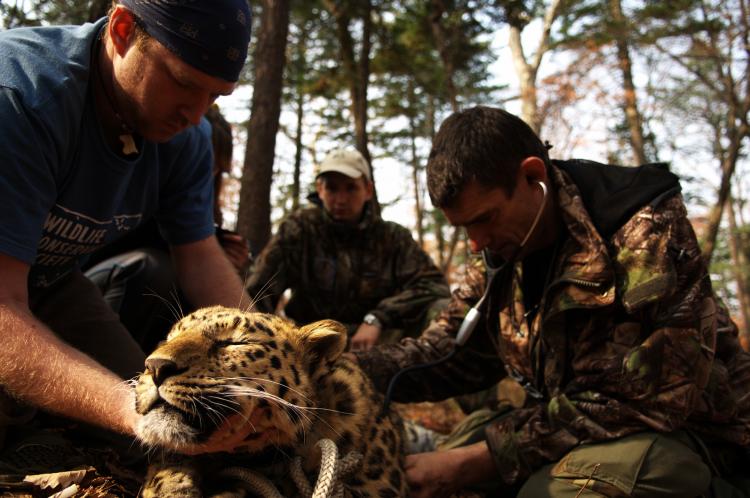Scientists have been analysing samples taken from the world’s rarest big cat.
Researchers from the Wildlife Conservation Society (WCS) and the Russian Academy of Sciences Institute of Biology and Soils (IBS) captured a female Far Eastern leopard, nicknamed “Alyona”, in Primorsky Krai , a narrow region of Russia bordered by China and North Korea, last week.
This subspecies has adapted to the cold Russian environment with its long pelt hair, measuring up to 7cm long in winter and has longer legs than the leopards found in humid Africa or south-east Asia. The rosette pattern on its fur is more widely spaced with thicker borders.
“This project has been ongoing for just over two years, and scientific work to capture Amur tigers and Far Eastern leopards in this part of Primorsky Krai has always been distinguished by the participation of world-class specialists and use of the best equipment and methodologies,” said Sergei Zubtsov, the head of Inspection Tiger, a Russian federal agency within the Ministry of Natural Resources.
Surviving along the Sino-Russian border, it is estimated that the population of this critically endangered species is between 25 and 40, among which there are approximately 10–15 females left.
Alyona was in good healthy physical condition, between eight to ten years of age and weighing 85lbs (39kg). After taking some blood samples and an electrocardiogram, she was released unharmed.
Both of these tests will reveal to scientists genetic information about the level of inbreeding within this tiny population and any symptoms of disease.
Previous captures of three leopards, two males and one female, in 2006 and 2007 have shown heart murmurs; a possible cause of genetic disorders from inbreeding.
Using camera-trapping and snow-tracking surveys, results indicate that over the past 30 years, population numbers have been stable, but with a high turnover rate.
Alexey Kostyria, PhD, IBS senior scientist and WCS-IBS project manager said, “We are excited by the capture, and are hopeful that ongoing analysis of biomedical information will confirm that this individual is in good health.”
“This research is critical for conservation of the Far Eastern leopard, as it will help us to determine the risks posed by inbreeding and what we can do to mitigate them.”
To increase genetic diversity, scientists are considering translocating foreign leopards to try to increase the gene pool.
One successful case occurred with Florida panthers, whereby animals from Texas were merged into the population to increase the remaining numbers. Originally at a low of ten, Florida panthers now number approximately 100.
Over the last century, Amur leopards have been hunted by poachers for their pelts and medicinal qualities and had their habitat destroyed by logging.
Their prey, Sika deer, wild board and hares are also hunted by locals. Forest produce are also a much needed source of income in southwest Primorye.
Local farmers who burn their fields to promote better growth of vegetation, often cannot control the fires, resulting in them spreading to the nearby forests, destroying the habitat.
Researchers from the Wildlife Conservation Society (WCS) and the Russian Academy of Sciences Institute of Biology and Soils (IBS) captured a female Far Eastern leopard, nicknamed “Alyona”, in Primorsky Krai , a narrow region of Russia bordered by China and North Korea, last week.
This subspecies has adapted to the cold Russian environment with its long pelt hair, measuring up to 7cm long in winter and has longer legs than the leopards found in humid Africa or south-east Asia. The rosette pattern on its fur is more widely spaced with thicker borders.
“This project has been ongoing for just over two years, and scientific work to capture Amur tigers and Far Eastern leopards in this part of Primorsky Krai has always been distinguished by the participation of world-class specialists and use of the best equipment and methodologies,” said Sergei Zubtsov, the head of Inspection Tiger, a Russian federal agency within the Ministry of Natural Resources.
Surviving along the Sino-Russian border, it is estimated that the population of this critically endangered species is between 25 and 40, among which there are approximately 10–15 females left.
Alyona was in good healthy physical condition, between eight to ten years of age and weighing 85lbs (39kg). After taking some blood samples and an electrocardiogram, she was released unharmed.
Both of these tests will reveal to scientists genetic information about the level of inbreeding within this tiny population and any symptoms of disease.
Previous captures of three leopards, two males and one female, in 2006 and 2007 have shown heart murmurs; a possible cause of genetic disorders from inbreeding.
Using camera-trapping and snow-tracking surveys, results indicate that over the past 30 years, population numbers have been stable, but with a high turnover rate.
Alexey Kostyria, PhD, IBS senior scientist and WCS-IBS project manager said, “We are excited by the capture, and are hopeful that ongoing analysis of biomedical information will confirm that this individual is in good health.”
“This research is critical for conservation of the Far Eastern leopard, as it will help us to determine the risks posed by inbreeding and what we can do to mitigate them.”
To increase genetic diversity, scientists are considering translocating foreign leopards to try to increase the gene pool.
One successful case occurred with Florida panthers, whereby animals from Texas were merged into the population to increase the remaining numbers. Originally at a low of ten, Florida panthers now number approximately 100.
Over the last century, Amur leopards have been hunted by poachers for their pelts and medicinal qualities and had their habitat destroyed by logging.
Their prey, Sika deer, wild board and hares are also hunted by locals. Forest produce are also a much needed source of income in southwest Primorye.
Local farmers who burn their fields to promote better growth of vegetation, often cannot control the fires, resulting in them spreading to the nearby forests, destroying the habitat.






